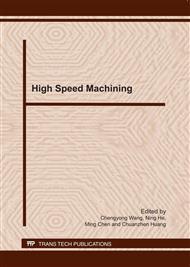[1]
YANG Guangyong: A Rapid Experimental Method of Tool Life [J]. Water Conservancy and Electric Power Machinery, (1984), p.11.
Google Scholar
[2]
P. Koshy, P. Dumitrescu, Y. Ziada. Novel methods for rapid assessment of tool performance in milling [J]. International Journal of Machine Tools and Manufacture, Vol. 44 (2004), p.1599–1605.
DOI: 10.1016/j.ijmachtools.2004.06.008
Google Scholar
[3]
TANG Xinru, YOU Shaojing. An Estimating Method of Shorter Time Test for Tool Life [J]. Journal of East China Shipbuilding Institute (Natural Science Edition), Vol. 2 (1988), p.138.
Google Scholar
[4]
YUAN Yuefeng, CHEN Wuyi, GAO Liansheng. Study on tool rapid selection based on the initial wear [J]. Chinese Journal of Aeronautics, Vol. 23 (2010), p.386.
DOI: 10.1016/s1000-9361(09)60232-6
Google Scholar
[5]
Su Y., He N., Li L. An experimental investigation of effects of cooling/ lubrication conditions on tool wears in high-speed end milling of Ti-6Al-4V [J]. Wear, Vol. 261 (2006), p.760.
DOI: 10.1016/j.wear.2006.01.013
Google Scholar
[6]
Pinaki Chakraborty, Shihab Asfoura, Sohyung Cho, et al. Modeling tool wear progression by using mixed effects modeling technique when end-milling AISI 4340 steel [J]. Journal of materials processing technology, Vol. 205 (2008), p.190.
DOI: 10.1016/j.jmatprotec.2007.11.197
Google Scholar
[7]
M. Serdar Karakas, Adem Acır, Mustafa Übeyli, et al. Effect of cutting speed on tool performance in milling of B4Cp reinforced aluminum metal matrix composites [J]. Journal of Materials Processing Technology, Vol. 178 (2006), p.241.
DOI: 10.1016/j.jmatprotec.2006.04.005
Google Scholar
[8]
A. Richetti, Á .R. Machado, M.B. Da Silva, et al. Influence of the number of inserts for tool life evaluation in face milling of steels [J]. International Journal of Machine Tools & Manufacture, Vol. 44 (2004), p.695.
DOI: 10.1016/j.ijmachtools.2004.02.007
Google Scholar
[9]
Won Tae Kwon, June Seuk Park, Shinhoo Kang. Effect of group IV elements on the cutting characteristics of Ti(C, N) cermet tools and reliability analysis [J]. Journal of Materials Processing Technology, Vol. 166 (2005), p.9.
DOI: 10.1016/j.jmatprotec.2004.06.009
Google Scholar
[10]
HUANG Shutao, JIA Chunde, JIANG Zenghui, et al. Cutting performance and wear mechanism of TiN coat cutter in high speed turn-milling [J]. Journal of Harbin Institute of Technology, Vol. 40 (2008), p.1501.
Google Scholar
[11]
SHU Biao, HE Ning, WU Kai. Study on the Milling of Ti Alloy in Nit rogen Gas Medium [J]. Aviation Precision Manufacturing Technology, Vol. 38 (2002), p.16.
Google Scholar
[12]
SU Yu, HE Ning, LI Liang, et al. Effects of Cryogenic Nitrogen Gas Jet on Machinability of Ti-Alloy in High Speed Milling [J]. China Mechanical Engineering, Vol. 17 (2006), p.1183.
Google Scholar
[13]
BIAN Rong, LI Liang, HE Ning, at al. Experimental Research on Tool Wear in High Speed Milling of PH13-8Mo Stainless Steel with Cryogenic Minimum Quantity Lubrication [J]. Tool Engineering, Vol. 43 (2009), p.14.
Google Scholar
[14]
. HUANG Shutao, JIA Chunde, JIANG Zenghui, et al. Research on Wearing Mechanism of Ceramic Tool in High Speed Dry Turning and Milling [J]. Manufacturing Technology & Machine Tool, (2001), p.35.
Google Scholar
[15]
YU Qixun. Machinability of High Manganese Steel ZGMn13. Water Conservancy & Eclectric Power Machinery, Vol. 23 (2001), p.38.
Google Scholar
[16]
WANG Rui, LIU Jia, WANG Xibin, et al. Experimental Investigation on Dry Milling Replace Semi-finishing Grinding of High-strength Steel [J]. Tool Engineering, Vol. 39 (2005), p.24.
Google Scholar
[17]
SHEN Bin, SUN Fanghong, XUE Hongguo, et al. Study on Fabrication and Their Cutting Performance of High-quality Diamond-coated Tools with Complicated Shape [J]. China Mechanical Engineering, Vol. 19 (2008), p.2287.
DOI: 10.1179/10.1179/026708408x334140
Google Scholar
[18]
. SHEN Zhong, SUN Xuan, LIU Gang et al. The Milling Mechanism of Ti6Al4V Based on Average Cutting Thickness [J]. Journal of Shanghai Jiaotong University, Vol. 41(2007): 614-623.
Google Scholar
[19]
JIANG Ligang, SUN Hua. Experiment on high speed milling spline with cutter with close clamp bits [J]. Machinery Manufacturing Engineer, (1998), p.6.
Google Scholar
[20]
HUANG Shutao, YU Junyi, JIANG Zenghui. Study on Wear Mechanism of Ceramal Tool in High-Speed Wet Turn-Milling D60 Steel [J]. Journal of Jilin University of Technology (Natural Science Edition), Vol. 31 (2001), p.6.
Google Scholar
[21]
WU Xin; ZHANG Liu; XU Feng. An Experimental Study on Tool Wear in High-Speed Milling of Titanium Alloy Parts [J]. Electro-Mechanical Engineering, Vol. 25 (2009), p.41.
Google Scholar
[22]
LIU Zhibing WANG Xibin YANG Hongjian. Experimental Research on Dry Milling of Ultra High-Strength Steel with Ceramic Cutters [J]. Tool Engineering, Vol. 37 (2003), p.7.
Google Scholar
[23]
SONG Changcai. High-speed Cutting Performance of New-type TiAlN Coating Milling Cutter [J]. Tool Engineering, Vol. 36 (2002), p.14.
Google Scholar
[24]
LIU Zhibing; WANG Xibin. Study on Cutting Performance of Cemented Carbide Inserts When Milling 30CrNi3MoV High-Strength Steel [J]. Mechanical Science and Technology, Vol. 24 (2005), p.383.
DOI: 10.1049/cp.2009.1423
Google Scholar
[25]
XIE Lijing, LIU Zhibing, WANG Xibin. Wear Mechanism of Cemented Carbide Insert in Milling of High-strength Steel [J]. Acta Armamentarii, Vol. 26 (2005), p.519.
Google Scholar
[26]
JIN Chengzhe, JIA Chunde, PANG Siqin. Wearing Mechanism of Tools in the Orthogonal Turn-milling of High Strength Steel [J]. Acta Armamentarii, Vol. 26 (2005), p.397.
Google Scholar
[27]
JIN Chengzhe, JIA Chunde. Research on Tool Life and Tool Wear Mechanics of High Strength Steel with Orthogonal Turn-milling [J]. Tool Engineering, Vol. 39 (2005), p.16.
Google Scholar
[28]
GENG Guosheng. Fundamental Research on High Speed Milling of Titanium Alloys [D]. Nanjing: Nanjing University of Aeronautics and Astronautics, (2007).
Google Scholar
[29]
LI Yubiao. Research on the Performance of PCBN Tools in Interrupted Cutting [D]. Dalian: Dalian University of Technology, (2009).
Google Scholar
[30]
WAN Yi. Study on the Tool Wear Mechanism and Tool Life for High-Speed Milling Aeronautic Aluminum Alloy[D]. Shandong: Shandong University, (2006).
Google Scholar
[31]
XIAO Jiming. Research on Cutting Performance and Wear Failure Mechanism of Graded Coating Hss Tools[D]. Xi'an: Xi'an University of Technology, (2007).
Google Scholar


